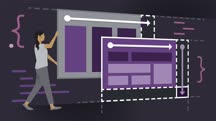Course catalog
Categories
Showing 381-400 of 1,450 items.
CSS: Combining Grid and Flexbox (220317)
With Grid and Flexbox, CSS is changing dramatically. Whereas in the past, creating complex layouts required all sorts of CSS hacks, JavaScript, or both, now you can use Flexbox and Grid—tools designed specifically for layouts—to create responsive web pages with precise, custom layouts. In this course, Emily Kay covers the basics of Flexbox and Grid separately, from syntaxes to properties to how they work in general. After that, she details instances where you may need to use both to accomplish your layout goals. As Emily shows, when you use Flexbox and Grid together to combine their separate strengths, you can create and display complex web content in a beautiful, user-friendly way.
CSS: Images (210610)
CSS is a toolkit for image manipulation. Whether you want to create distinctive visual effects or simply make the most of available bandwidth, the options for manipulating images in CSS will let you create reusable graphics solutions. In this course, instructor Morten Rand-Hendriksen shows you how much you can edit images in a browser using pure CSS. Morten explains the importance of proper HTML image markup and how to crop, fit, and position an image. He discusses how to use the clip-path property to create a variety of shapes. Morten shows how you can use and combine filters to edit and add effects to your image. He concludes by walking you through several practical examples of how to use what you learned, as well as some important best practices and caveats.
CSSLP Cert Prep: 6 Secure Lifecycle Management (230024)
Change is a certainty throughout the software development lifecycle (SDLC). To enhance the security state of their organization’s software, information security professionals must create a lifecycle management program that lays out how to apply clear security standards throughout the SDLC. In this course, the sixth installment of the CSSLP Cert Prep series, instructor Jerod Brennen dives into the subject of secure software lifecycle management, helping prepare you for the sixth domain of the Certified Secure Software Lifecycle Professional (CSSLP) exam: Secure Software Lifecycle Management. Jerod discusses how to define your strategy and roadmap, manage security in both adaptive and predictive methodologies, and promote security culture within your organization. He also discusses the importance of generating and maintaining software security documentation, developing security metrics, applying lessons learned to enable continuous improvement, and more.
CSSLP Cert Prep: 7 Software Deployment, Operations, and Maintenance (228018)
The Certified Secure Software Lifecycle Professional (CSSLP) is a globally recognized certification from (ISC)2. In this course, part seven in an eight-part series, instructor Jerod Brennen provides insights and context around the seventh domain of the CSSLP certification exam: Secure Software Deployment, Operations, Maintenance. Jerod teaches you the essential components of an operational risk analysis. He shows you how to securely store and manage credentials, secrets, keys, certificates, and configurations. He covers bootstrapping, environment hardening, and applying the principle of least privilege. Then he steps you through the security testing you should perform post-deployment. He discusses obtaining the security approval needed to operate your production app and performing information security continuous monitoring (ISCM). In conclusion, Jerod walks you through how to maintain your software, including how to scan, track, and triage vulnerabilities.
Cultivate Healthy Ambition (214078)
Sometimes, when we think of an ambitious person, we imagine someone with unfettered drive to achieve what they want, no matter the cost. And sadly, for some people, this unhealthy sort of ambition is a reality, and it can affect a person’s mental or physical health, relationships, and happiness. But there’s also a healthier version of ambition, one that can lead to greater levels of performance, deep personal learning, and a gratifying sense of purpose. In this course, best-selling author and management consultant Ron Carucci teaches you the three components of healthy ambition: Performance ambition, growth ambition, and achievement ambition. Ron shows how to balance the right degree of each component, and avoid the pitfalls of too much, or too little, of any of them. If you’re looking to reinvigorate your sense of what your future could hold, join Ron in this course.
Cultivating Presence and Impact in a Live and Virtual World (230279)
Virtual meetings, presentations, and corporate reviews might be here to stay. Are you ready to present yourself at your brightest and most positive, online? In this course, Joan Kuhl—a master communicator, corporate trainer, and champion of women in the workforce—shows you how to cultivate and polish your authentic presence anytime, anywhere. Joan explains how to overcome imposter syndrome by owning your own success and becoming your own champion. She discusses identifying and owning your strengths, as well as how to identify a key area of insecurity and reframe your thoughts into positive. Joan covers being seen, heard, and valued in the workplace, both on and off the screen. She describes several strategies for overcoming politics and conflict in the workplace. Joan goes into techniques to manage your reputation, then concludes with ways you can thrive in challenging times.
Note: This course was created by genConnectU. We are pleased to host this training in our library.
Note: This course was created by genConnectU. We are pleased to host this training in our library.
Customer Service: Creating Customer Value (214316)
If you are a customer service manager or a sales manager, you know how important it is to identify a customer’s value to your company. But how do you assign the value? How do you determine what is most valuable to your company? In this course, instructor Noah Fleming walks you through ways to define, create, and evaluate customer value. Noah explains both the way the business defines customer value and the way the customer defines value. He goes over a number of simple ways to create customer value and ways to measure customer value. Then Noah dives into the value narrative, covering steps like understanding value over price, reviewing your company messaging, and reshaping your value narrative. He finishes up with some advanced tips, such as proactively extracting customer value, considering current value vs. future value, and sorting from low value to high value.
Customer Service: Creating Customer Value (2015) (226114)
Is your product or service worth the price? Even if you think so, an army of competitors is deluging your loyal customers with messages to the contrary. Customer loyalty expert Jill Griffin explains how customers form perceptions of your brand, why they switch brands, and how you can manage the relationship between your brand, your product/service, and your price—so they see why your offering is valuable and remain loyal. She offers seven proven methods to maximize value and differentiate your product/service, drawing on real-world examples from companies such as Zappos, 3M, and Amazon. Plus, get a 10-day action plan that will help your company or team find fresh ways to bring value to customers.
Cybersecurity Awareness: Social Engineering (221677)
Social engineering is one of the most dangerous forms of hacking because it preys on human nature. Learn how to defend your organization from social engineering by recognizing and thwarting the most common types of attacks. This course provides security teams and professionals with information on common social engineering techniques and safeguards. Instructor Stephanie Ihezukwu—a security analyst and engineer—describes how phishing, vishing, baiting, and physical activities like tailgating all provide entry to bad actors, and explains how training can be the most effective tool to combat these attacks. She also explains how to create policies and procedures; set up controls around passwords, email, and software updates; and conduct tests to see how effective your defenses truly are.
Daniel Pink on Motivation (216832)
The central task of leaders and managers is to help their people perform at their best and contribute the most. In this course, join #1 New York Times best-selling author Daniel Pink as he shares science-backed methods for effectively motivating others. With his trademark clarity, Pink distills the crucial research on human motivation. And he shares practical takeaways in the three key areas lead to enduring high performance: autonomy, mastery, and purpose. Pink teaches a group exercise to help surface your team’s purpose, then shows you how to create a sense of connection. He explains the secrets of effective feedback and how to promote progress using simple 90-second practices. And since offering employees space to make small changes in their jobs can dramatically boost engagement, Pink walks you through how to carve out small islands of autonomy to spark your team’s innovation and deepen their commitment.
Data Analytics: Dashboards vs. Data Stories (218158)
In the world of data analytics, you're consistently presented with the same decision when it comes to how you'll communicate your data and insights. For each project, you need to decide whether to use a dashboard or tell a data story. In this course, business intelligence architect Sara Anstey provides you with the necessary information you need to make this decision with confidence. First, Sara covers the fundamentals of making decisions with data and shares how the role of a data analyst makes this possible for organizations. She then dives into the topics of data science dashboards and data storytelling, highlighting the pros and cons of each and providing the details you need to determine which approach is right for you. Sara closes by recapping key concepts, leaving you prepared to pick between each of these options with ease and intentionality.
This course was created by Madecraft. We are pleased to host this training in our library.

This course was created by Madecraft. We are pleased to host this training in our library.

Data Analytics: Graph Analytics (213806)
Since the inception of data analytics, the way in which analysts view and interpret data has evolved tremendously. New technologies, tools, and approaches have advanced what's possible with data analytics, and network analysis is no exception. In this course, longtime data analyst and data visualization expert Heather Johnson shares the fundamentals of using graph analytics, or network analysis, when analyzing data. Heather begins by reviewing the components of a network analysis and detailing the advantages of using a graph analytics approach. She then walks through key applications of using graph analytics when reviewing data. To wrap up the course, Heather discusses career opportunities within the realm of graph analytics. Upon completion, you’ll be equipped with the knowledge of what graph analytics is and how it can be leveraged within your analytics career.
This course was created by Madecraft. We are pleased to host this training in our library.

This course was created by Madecraft. We are pleased to host this training in our library.

Data Ethics: Watching Out for Data Misuse (220504)
Technology has given organizations an opportunity to work with data in interesting new ways, but now governments, citizens, and customers are taking a close look at how companies use or misuse data. If one of your customers posts harmful information, should you take it down? Can you use data to manipulate your customer’s behavior? The answers to these questions have an enormous impact on how your customer views your organization. Yet, these decisions aren’t happening in the boardroom. Instead, they’re made in much smaller meetings by people just like you. Instructor Doug Rose gives you the understanding and skills you need to discuss these issues in a way that's both meaningful and productive. Doug begins with ethical views that you need to consider. He goes over ways data can be misused, by a company and by a customer. Then Doug goes over the responsibility to be accurate and what you can do when inaccurate materials are propagated. He concludes with an overview of data challenges. This course was created for LinkedIn Learning by Doug Rose. We are pleased to offer this training in our library.
Data for Good: Using Data Science in Nonprofits and NGOs (226080)
The revolution in data science has transformed, for better or worse, the way companies do business in the last few decades. But data science isn't just for capitalists. AI is one of the most important forces for change developed in the last century, and we've only begun to recognize its true power and potential. In Data for Good: Using Data Science in Nonprofits and NGOs, Martin Kemka examines how data science and machine learning can be used outside of the for-profit sector. He covers parameters for how data works to influence our world, how the data-for-good concept can be applied, how to determine the best problems to solve with data, and what tools are needed. Martin also provides real-world case studies and challenges to further illustrate the lessons.
Data Science for Java Developers (225281)
Learning the basics of data science and how to apply them in Java opens up a world of possibilities for you, in terms of building software and job opportunities. In this course, instructor Shaun Wassell takes you through the skill sets required for data science, shows you how to visualize data in Java, and explores different methods of turning data into information. Shaun introduces some basic concepts and examples of data science, then walks you through the process of representing data in Java and some difficulties you may encounter. He discusses data manipulation techniques like mapping, filtering, collecting, and sorting. Shaun describes how to find, gather, clean, manipulate, and store data, so that you can start doing useful things with it. Next, he shows you the fun part: different methods you can use to turn data into information. Shaun covers Nearest-Neighbor, Bayes, linear regression, decision trees, clustering, and more.
Data Science Foundations: Data Mining in Python (209862)
Data mining is the area of data science that focuses on finding actionable patterns in large and diverse datasets: clusters of similar customers, trends over time that can only be spotted after disentangling seasonal and random effects, and new methods for predicting important outcomes. In this course, instructor Barton Poulson introduces you to data mining that uses the programming language Python. Barton goes over some preliminaries, such as the tools you may use for data mining. He discusses aspects of dimensionality reduction, then explains clustering, including hierarchical clustering, k-Means, DBSCAN, and more. Barton covers classification, including kNN and decision trees. He goes into association analysis and introduces you to Apriori, Eclat, and FP-Growth. Barton steps you through a time-series decomposition, then concludes with sentiment scoring and other text mining tools.
Data Science Foundations: Data Mining in R (227253)
Data science continues to grow in sophistication and demand at an exponential rate. Data mining is the area of data science that focuses on finding actionable patterns in large and diverse datasets: clusters of similar customers, trends over time that can only be spotted after disentangling seasonal and random effects, and new methods for predicting important outcomes. Instructor Barton Poulson focuses on data mining in R, presents a broad range of algorithms including machine learning methods, and offers important information on laws and policies that affect data mining. Barton gives an overview of dimensionality reduction. He introduces clustering, including hierarchical clustering, then goes into association analysis. He explains time-series mining and decomposition, then concludes with text mining, sentiment analysis, and sentiment scoring.
Data Science Foundations: Knowledge Graphs (219416)
The term “knowledge graph” describes a semantic search based on the systematic compilation and processing of data and was first coined by Google. Leading internet companies have been using knowledge graphs for several years to present information that is tailored to customers’ needs. You can also use knowledge graphs to map your company’s internal knowledge and improve search results. Knowledge graphs can also improve the results of AI or machine learning systems. In this course, blockchain technology leader Daniel Burgwinkel explains what knowledge graphs are, offers examples and use cases, gives you practical recommendations on how to implement knowledge graphs, and shows you how to build a knowledge base. This course is aimed at data stewards, digital transformation managers, and data scientists who are responsible for data stocks and knowledge management.
Data Science Methodologies: Making Business Sense (209930)
There is an increasing recognition that data science needs to go beyond small-scale experimentation to a large-scale implementation. In this course, Neelam Dwivedi brings software engineering and data mining methodologies to data scientists, then applies these ideas by taking a simple business need through an entire life cycle—hosting a model, consuming it in a web application, and setting up its CI/CD pipeline. Neelam begins by explaining the methodologies used in the course and how they are combined. She shows you where to begin in developing architecture and deploying a model, then explains how larger web applications may consume the model as a service. Neelam covers how to stage your model and the app, as well as how to plan ahead with an overall roadmap. She concludes with thoughts on how to further applications of data science methodologies.
Data Steward Foundations (219450)
Data stewardship programs help organizations achieve the maximum value from their information assets. In this course, instructor Mike Chapple shows you the basic foundations of data stewardship and best practices for getting your own data stewardship program off the ground. Mike explores the roles, qualities, and responsibilities of a data steward. He goes over best practices for maintaining data quality, then explains the many protections that go into maintaining data security. Mike discusses privacy controls and the patchwork of international, national, and local laws that govern data security and privacy. He concludes with useful steps you can take in building a data stewardship program.



















